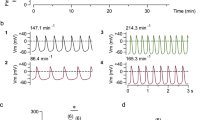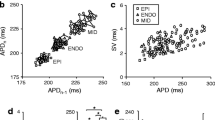Abstract
SEVERAL investigations have suggested a role for K+ in the generation of the transmembrane potential during spontaneous rhythm1,2 and following vagal inhibition3,4 of the sinoatrial node (SA node) of the heart5. Voltage-clamp studies1,2 in the rabbit SA node have shown a voltage- and time-dependent increase in the outward current on depolarisation and a slow decay of the outward current on repolarisation to the holding potential. The hyperpolarisation and slowing of automaticity following vagal stimulation or acetylcholine (Ach) application is believed to be due to an increase in potassium permeability3,4. The purpose of the present study was to use K+-sensitive microelectrodes6,7 to examine the time course and the magnitude of K+ efflux and extracellular accumulation in the isolated rabbit SA node during spontaneous rhythm and following vagal stimulation. Our results confirm that K+ permeability of the sinoatrial pacemaker cell is increased following vagal stimulation and demonstrate K+ accumulation in the extracellular space for several seconds. Beat-to-beat extracellular potassium transients are linked to the repolarisation process as well as to diastolic depolarisation.
Similar content being viewed by others
References
Noma, A. & Irisawa, H. Pflügers Arch. ges Physiol. 364, 45–52 (1976).
Seyama, I. J. Physiol., Lond. 255, 379–397 (1976).
Trautwein, W., Kuffler, S. W. & Edwards, C. J. gen. Physiol. 40, 135–145 (1956).
Harris, E. J. & Hutter, O. F. J. Physiol., Lond. 133, 58P–59P (1956).
Copenhaver, W. M. & Truex, R. C. Anat. Rec. 114, 601–625 (1952).
Walker, J. L. Analyt. Chem. 43, 89A–93A (1971).
Kline, R. P. & Morad, M. Biophys. J. 16, 367–372 (1976).
Paes de Carvalho, A., DeMello, W. C. & Hoffman, B. F. Am. J. Physiol. 196, 483–488 (1959).
Spear, J. F. & Moore, E. N. in Neural Mechanisms in Cardiac Arrhythmias (ed. Schwartz, P. J.) 167–178 (Raven, New York, 1978).
Vincenzi, F. F. & West, T. C. J. Pharmac. exp. Ther. 141, 185–194 (1963).
Summerfield King, T. & Coakley, J. F. J. Anat. 92, 353–376 (1958).
Neher, E. & Lux, H. D. J. gen. Physiol. 61, 385–399 (1973).
Kunze, D. L. Circulation Res. 41, 122–127 (1977).
Kriz, N., Sykova, E. & Vyklicky, L. J. Physiol., Lond. 249, 167–182 (1975).
Page, S. & Niedergerke, R. J. Cell Sci. 11, 179–203 (1972).
Kawamura, K. Jap. Circul. J. 25, 973–991 (1961).
Lux, H. D. & Neher, E. Expl Brain Res. 17, 190–205 (1973).
Lux, H. D. J. Neuropharmac. 13, 509–517 (1974).
Author information
Authors and Affiliations
Rights and permissions
About this article
Cite this article
KRONHAUS, K., SPEAR, J., MOORE, E. et al. Sinus node extracellular potassium transients following vagal stimulation. Nature 275, 322–324 (1978). https://doi.org/10.1038/275322a0
Received:
Accepted:
Issue Date:
DOI: https://doi.org/10.1038/275322a0
- Springer Nature Limited





